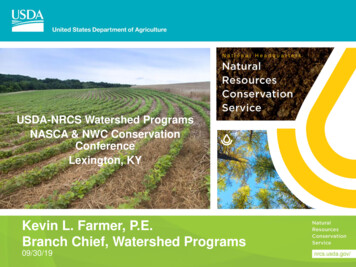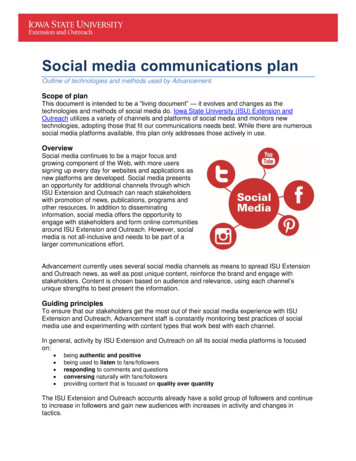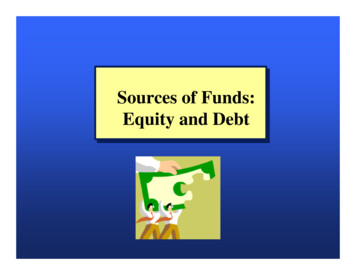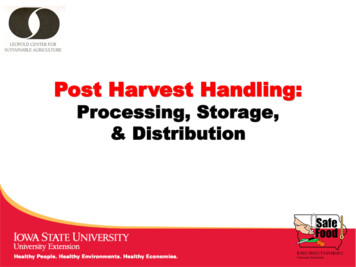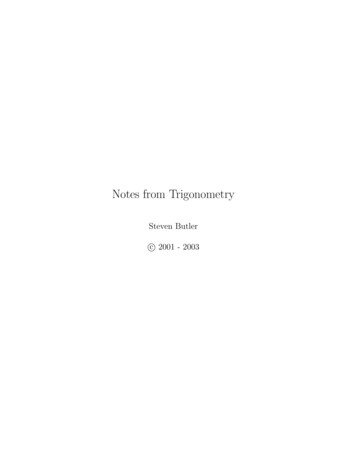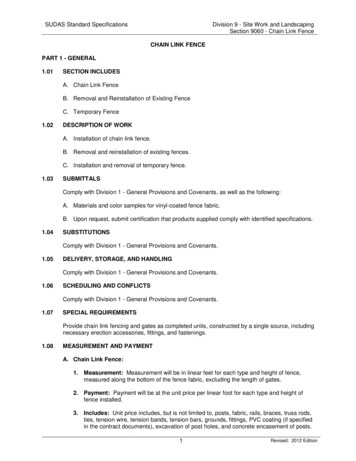
Transcription
IowaCurrentDevelopmentsTUSDA Natural Resources Conservation Service, 210 Walnut St., Room 693, Des Moines, IA 50309From the Office ofIowa State ConservationistRick Van KlaverenWhat’s inside.Partners Improve Viking LakeWatershedButler County in the NewsAbsentee Landowner OutreachIowa ACES at WorkSolar Pump ProducesGaga for GourdsPersonnel ActionsPage 2Page 3Page 3Page 4Page 4Page 5Page 6"Iowa Natural Resources ConservationService: Excellence in helping peopleconserve and improve our natural resources,communities, and environment."USDA is an equal opportunity provider andemployer.Winter 2007he 2007 budget remains very tight. It is looking a little better now, but budget challenges remain.Sometime between now and February 15 we expectto hear more from Congress on our finances for the rest ofthe year. We will probably operate under a continuing resolution the balance of this fiscal year, but the question is, willit be the FY06 allocation or the proposed Senate or Housemark?In the meantime, conservation work continues. If thisyear’s budget challenge has taught us anything, it is thatwe need to continue to work as smart as we can. We mustcontinue to leverage funding opportunities and work withpartners to do our jobs.A very good example of this cooperation of labor andfunding aimed a specific goal can be found in the VikingLake Watershed in Montgomery County in SouthwesternIowa. This 2200-acre watershed drains into one of Iowa’smost popular state parks. This watershed had challenges.The nearby cattle feedlot, overloaded septic systems andsoil erosion all contributed to very poor water quality in thewatershed that ended up preventing some swimmers fromusing the park’s lake. Now, after two and a half years ofwork and a half million dollars from many sources, NRCS,the district, and seven other partners have nearly completed work that will transform this watershed and park into ashowcase of cooperative conservation.Congratulations to the staffs at the Red Oak Field andRed Oak Engineering Offices, and to all the partnershipemployees at every level for your work on Viking Lake andfor reminding us what can be accomplished through partnerships and teamwork.
Iowa Current DevelopmentsPartners Improve WatershedIt was well known that the very popular Viking Lake State Park inMontgomery County had water qualityissues. The park’s 147-acre lake hadhigh enough bacterial levels at timeslast summer that the Iowa Departmentof Natural Resources advised againstswimming in it. Water quality was badand getting worse. Blue-green algaewere blooming and waterways withinthe watershed were on the impairedlist.Local conservation leaders knewsomething had to be done and donequickly. Work began in 2004 to turnthings around, through the teamworkof many partners that included theDNR, the Iowa Department ofTransportation, Page One Rural WaterDistrict of Clarinda, Montgomery Soiland Water Conservation District, IowaDepartment of Agriculture and LandStewardship’s Division of SoilConservation, and NRCS.Looking at the entire 2200-acrewatershed around Viking Lake, thepartners did a comprehensive watershed analysis to complete a work planTouring one of the 22 new structuresdesigned to improve water qualitywithin the watershed surroundingViking Lake State Park are Gary Poen,DNR park ranger; Brian Holmes,NRCS engineer; Galen Hartman,Montgomery County NRCS soil conservation technician; Bob Waters,IDALS regional watershed coordinatorfor western Iowa; Tom Burkhiser,Helping People Help the Landand received grants from a number ofdifferent sources to fix a number of different problems.All told, about 420,000 was spent onconservation practices within the watershed.Now that much of the work is done,partners are looking forward to seeingthe benefits of their work this summer.Thanks to the new structures’ sedimentcontrol, the DNR expects the water inViking Lake to be very clear this spring.Experts predict bacteria concerns willbecome a distant memory. Anglers willenjoy 17 new fishing ponds that are aresult of new erosion control structures.Park goers will be able to explore fivenew miles of hiking trails originallymade to move equipment from one construction site to the next. As a result ofall of the completed conservation work,sediment entering Viking Lake is predicted to drop from 5,000 tons per yearto 150 tons. That means swimmers,boaters and campers can expect excellent water quality in Viking Lake.That’s an environmental improvement that can bring a smile to any parkvisitor’s or conservationist’s face.Montgomery County NRCS districtconservationist; Denise Miller, EastPottawattamie County NRCS soil conservation technician; Terry Gleaves,East Pottawattamie County NRCS soilconservation technician; Daniel Case,IDALS environmental specialist project coordinator; and Dave Burmeister,East Pottawattamie County districtbuffers specialist.Winter 2007Iowa is Home to NationalNRCS OfficeA four person NRCS office locatedin Des Moines has a big impact onconservation across the United States.The national Earth Team Volunteer andLandcare Publications office providesinformation and manages the volunteers that many local offices use to further conservation work.The Earth Team group works toincrease the use of volunteers in conservation. In 2005, nearly 35,000 EarthTeam Volunteers donated almost onemillion hours of their time to conservation practices. The total value of thevolunteer time was over 16 million.The publications section keepsinventory and processes orders fromacross the nation for NRCS publications, forms and exhibits for agencyand general public use.Districts may place orders by calling 1-888-LANDCARE, or by visitinghttp://landcare.nrcs.usda.gov.The people that make up the fourperson team at the national EarthTeam Volunteer and LandcarePublications office are Bonnie Allely,volunteer liaison; Michele Eginoire,national Earth Team volunteer coordinator; Venessa Alvarado, officeassistant; and Alan Benge, programassistant. They are standing in frontof one of the many LANDCARE displays districts can order from them.Page 2
Butler County in the NewsIowa Current DevelopmentsDistrict Conservationist LawrenceGreen is proud of the conservationwork the landowners and staff are putting in place in Butler County. Soproud, in fact, that Green invited JeanCaspers-Simmet, a writer for farm publication AgriNews, to write a story onconservation in Butler County. CaspersSimmet agreed and joined him at thefather/son Lee and Russ Meyer farmnear Aplington.The Meyers have a long tradition ofworking with Green and the Butler Soiland Water Conservation District staff onconservation projects. For example,there are over three miles of terracesand one mile of stream bank buffersinstalled on their property. They have36 acres of well head protection in placealong with three wetland restorationsand two ponds.Green and the Meyers showedJean Caspers-Simmet, a reporter withthe Rochester, MN, based AgriNewsstands in front of a new manure settling basin with Butler County DistrictConservationist Lawrence Green andfarmers Russ and Lee Meyer. Greeninvited Caspers-Simmet to see anHelping People Help the LandCaspers-Simmet their latest conservation project which involves building aconcrete manure settling basin, a 500foot filter strip, and a filter channel withlevel spreaders that empties into a wetland. The project was designed by CivilEngineering Technician Jeff Lutz andSoil Conservation Technician MichaelLuebbers, and built by the Meyers.Green said all the work meets projectspecifications.Russ Meyer said, “I’m feeling verygood about it. It’s worked well.”Caspers-Simmet’s Butler Countyconservation story appeared January 16.Green is happy because now the readers of AgriNews have a better understanding of the conservation practicesthat are installed in Butler County.On the web: 447840.bsp.example of conservation practices putin place on Butler County farms. TheMeyers say the settling basin improveswater quality and makes it easier toclean up manure produced on theircattle feedlot.Winter 2007Iowa NRCS PrintsConservation AtlasThe latest brochure produced byIowa NRCS is the “Iowa NRCSConservation Atlas.” This 16-pagebooklet includes tables, maps, and feature stories about our Farm Bill programs, plus maps showing the status ofPL-566 and PL-534 projects in the state.Limited copies of the atlas will bemailed to each field office in the comingweeks. As always, this brochure is onthe Iowa NRCS website s.html.For more information about theatlas, contact Jason Johnson at515-323-2701.RC&D Reaches Out toAbsentee LandownersConservationists have an ongoingchallenge to find absentee landownersand help them address resource concerns on their Iowa farms. Whenlandowners are contacted, they oftenfind the language surrounding conservation confusing and too technical.M & M Divide ResourceConservation and Development(RC&D) in Carroll is trying to fix thatproblem. They received two largegrants that allow them to find namesand addresses of absentee landowners,contact them and develop tools to helpthose landowners better addressresource concerns on their land.One of the outreach tools developedthat anyone can use is the websitewww.absenteelandowners.org. M & MDivide RC&D Coordinator Rick Tafoyasays, “The website uses easily readablelanguage to empower absenteelandowners to become more engagedin what happens on their land.” Tafoyasays it is also a great resource for useby NRCS and partner staff.Page 3
Iowa Current DevelopmentsACES Employees are Asseststo Iowa NRCSMonona County ACES employeeClarence Phipps stands in front of aconverted pivot irrigation system.Phipps is involved in an EQIP conversion program where farmers converttheir high pressure irrigation systemsto low pressure.Clarence Phipps, working under theAgricultural ConservationEnrollees/Seniors (ACES) Project inMonona County, is one of 28 enrolleesworking in field offices around Iowa.The program allows NRCS to obtain theservices of experienced workers age 40and over on a temporary basis throughan agreement with the National OlderWorker Career Center (NOWCC). TheNOWCC is a non-profit organizationthat recruits the enrollees and handlesthe administrative recruiting, hiring,and paying of ACES participants.A lifetime of living and farming inMonona County has given Phipps aworking knowledge of the land and therespect of many residents. He also carries a Certified Crop Advisor accreditation and has managed a local co-op inthe past.Although he has worked intermittently for the Monona Soil & WaterConservation District during the pastfive years, this program allows theMonona County SWCD the opportunityto keep him employed and remain anasset to the staff.One of Phipps’ primary dutiesinvolves the Environmental QualityHelping People Help the LandIncentives Program (EQIP) Ground andSurface Water Conservation (GSWC)Program. In Monona County, Phippsworks with producers to convert pivotirrigation systems from high to lowpressure to conserve water. The districthas relied on Phipps to get the costshare program started and to help staffand producers understand the varioustypes of systems and their conversioncomponents.Monona County DistrictConservationist Kathy Schneider isextremely pleased with both ClarencePhipps and ACES. Schneider says, “TheACES Project provides us with themuch needed assistance to put moreconservation on the ground. Clarence isan asset to the office, bringing years ofwisdom to the position and is a pleasant contribution to the office staff.”Solar Pump ProducesIowa Lakes RC&D Coordinator JeffKestel and farmer Del Roskensinspect a solar powered water pumping demonstration site. Used as atool for managed grazing, the systemprovides water for cattle where electricity is unavailable. The Iowa LakesRC&D council helped install fivedemo sites in their region. Even onthe cold, snowy January day that thisphoto was taken, the men found thesolar powered pump working well.Winter 2007NRCS and DNR Team onLake ProjectThe Iowa Department of NaturalResources credits work completed bythe Garner field office staff for helpingmake the Crystal Lake renovation happen in Hancock County.Before any dredging could takeplace, the watershed around stateowned Crystal Lake needed to beimproved so excessive runoff fromfarm fields wouldn’t wash into the lakeand create even more sediment. Afterinstalling soil erosion measures withinthe watershed, the 268-acre CrystalLake State Park is now undergoing a 3 million dredging to deepen the lakeand to improve water quality.Garner Field Office staff gather for agroup picture in the Crystal LakeWatershed. They are David Knoll,environmental specialist; LucasMiller, soil conservation technician;Jason Moore, district conservationist;Ruth Ehley, soil conservationist; andDarla Reding, state secretary. TheIowa DNR credits watershed soil erosion work done by the Hancock Fieldoffice for making possible a 3 milliondredging operation in Crystal Lake.Page 4
NRCS Focuses on BlackHistory and HeritageIowa Current DevelopmentsJanuary and February are importantmonths for celebrating the contributionsof Blacks in American life and history.In January we celebrate the birth andlife of Dr. Martin Luther King, Jr. with anational holiday. February is BlackHistory Month whichhas been recognizedsince 1926 as an initiative to bring nationalattention to the contributions of black peoplethroughout Americanhistory.ShafferAs black emphasisRidgewayprogram manager forIowa NRCS, Shaffer Ridgeway helpsIowa NRCS to keep a year round focuson the issues of inclusion and equality.Ridgeway is the Black Hawk CountyDistrict Conservationist.The Black Emphasis Program isdesigned to provide focus on issuessuch as employment, promotion, training and career enhancement for blackemployees and applicants in NRCS.Kids Go Gaga forGourdsHumboldt County DistrictConservationist Allison Orr(center) and Area 2Ad
the Rochester, MN, based AgriNews stands in front of a new manure set-tling basin with Butler County District Conservationist Lawrence Green and farmers Russ and Lee Meyer. Green invited Caspers-Simmet to see an example of conservation practices put in place on Butler County farms. The Meyers say the settling basin improves

